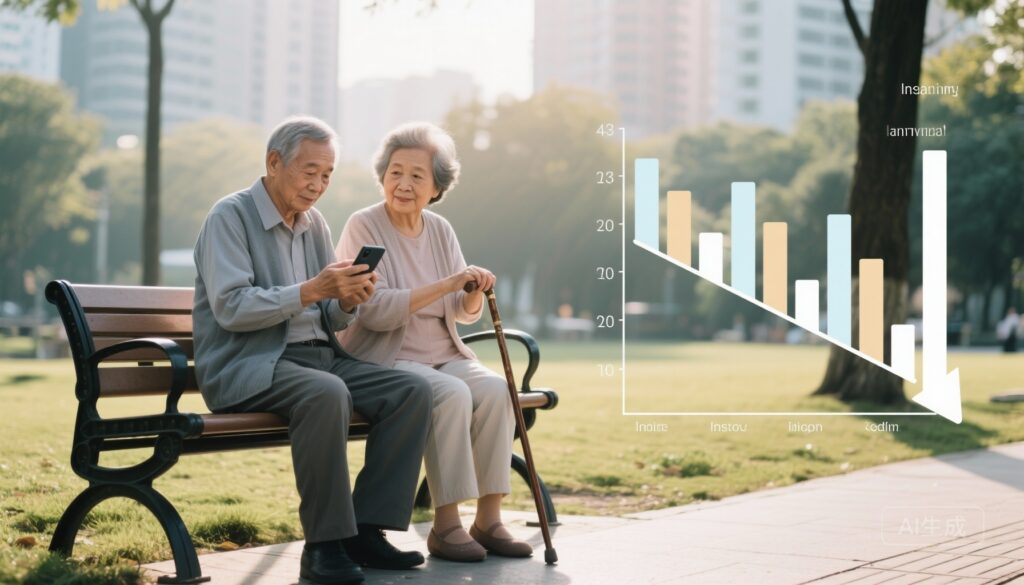Highlight
– In the BLINDSCE cohort (n=2,044 older adults), each extra hour of daily sedentary time was linked to a 1.18-point lower baseline intrinsic capacity (IC) score (95% CI -1.38 to -0.98) and a 0.48-point greater IC decline over one year (95% CI -0.72 to -0.24).
– The exposure–response relationship between sedentary time and 1-year IC change was linear; interactions were observed by baseline IC, moderate-to-vigorous physical activity (MVPA), and daily internet use.
– Findings support targeting sedentary behavior reduction alongside promotion of MVPA and moderated digital engagement as operational strategies to implement WHO’s ICOPE framework for healthy ageing.
Background
Intrinsic capacity (IC) — the composite of an individual’s physical and mental capacities — is a central construct in the World Health Organization’s agenda for healthy ageing and the Integrated Care for Older People (ICOPE) framework. Declines in IC predict increased risk of disability, dependence, and worse health outcomes. While non-modifiable factors (age, multimorbidity) influence IC, lifestyle behaviours are potentially modifiable levers to preserve capacity and delay functional decline.
Sedentary behaviour (prolonged sitting or low-energy posture during waking) is highly prevalent in older adults and has emerged as an independent risk factor for cardiometabolic disease, cognitive decline, and mortality. However, whether and how sedentary time relates to the multidomain construct of IC, and whether it predicts short-term decline in capacity, has been underexplored.
Study design
This report interprets findings from Cheng et al. (2025), who analysed data from the Beijing Longitudinal Disability Survey in Community Elderly (BLINDSCE) cohort collected in 2023–2024. The study enrolled community-dwelling adults aged 65 years or older (n=2,044) at baseline; 1,576 participants completed face-to-face assessments after one year.
Key exposures and outcomes:
- Sedentary time: reported average daily sedentary hours (method details in the original paper).
- Intrinsic capacity: a composite score reflecting multiple domains (likely including locomotion, cognition, vitality, sensory, and psychological capacity) operationalized per ICOPE-aligned constructs.
- Covariates: multivariable models adjusted for demographic, clinical, and lifestyle confounders, including MVPA.
- Baseline IC level — the association between sedentary time and subsequent decline varied by initial capacity state, suggesting those with lower baseline IC might be more vulnerable (or, alternatively, that behavior matters more at certain capacity strata).
- Moderate-to-vigorous physical activity (MVPA) — higher MVPA attenuated the negative association between sedentary time and IC decline, consistent with a compensatory or buffering effect of regular activity.
- Daily internet use — surprisingly, moderate internet use appeared to modify the association, raising the possibility that cognitive/social engagement through digital media may mitigate some adverse effects of sedentary time.
- Measurement: Sedentary time was likely self-reported in BLINDSCE; self-report is susceptible to recall and social desirability bias. Objective accelerometry would strengthen causal inference and refine thresholds.
- Residual confounding and reverse causation: Although adjusted analyses attempted to account for comorbidity and baseline functioning, sicker individuals may sit more (reverse causality). The prospective design reduces but does not eliminate this concern.
- Short follow-up: One-year change is informative for short-term trajectories but cannot capture longer-term patterns or outcomes such as incident disability, institutionalisation, or mortality.
- Generalisability: The cohort comprises community-dwelling older adults from Beijing; cultural, environmental, and healthcare factors may affect external validity.
- Operational definition of IC: Composite scoring methods vary. Harmonisation across studies is needed to compare effect sizes and clinical meaning of IC-point changes.
- Screen for sedentary behaviour in routine assessments of older adults (ask about daily sitting time and contexts — TV, transport, reading, socialising).
- Advise incremental reductions in sitting: break up prolonged sitting every 30–60 minutes with light activity or standing, encourage standing tasks, household chores, or short walks. Even modest reductions appear beneficial given the linear relationship observed.
- Promote MVPA according to WHO guidelines (at least 150–300 minutes of moderate-intensity or 75–150 minutes of vigorous-intensity activity per week, adapted to individual capacity) as MVPA may buffer sitting-associated decline.
- Leverage digital tools judiciously: moderate internet use that supports cognitive engagement and social connection may mitigate some adverse effects of sedentary time; tailor recommendations to digital literacy and safety.
- Implement IC-stratified interventions: identify older adults with low baseline IC who may benefit most from targeted sedentary reduction plus rehabilitation, and integrate behaviour-change support into ICOPE pathways.
- Use objective measures (accelerometers, inclinometers) to quantify sedentary patterns (bouts, breaks) and relate them to IC domain trajectories.
- Extend follow-up to link sedentary behaviour and IC change with hard outcomes (disability, care dependence, mortality).
- Conduct randomized controlled trials testing sedentary reduction interventions (behavioural counselling, environmental changes, technology prompts) and factorial designs combining MVPA promotion and cognitive/social engagement to determine causality and optimal strategies.
- Investigate mechanisms linking sitting with domain-specific changes in IC (muscle mass, inflammatory markers, cerebrovascular function, sleep, mood).
- Assess cost-effectiveness and implementation pathways within ICOPE and primary care frameworks for scalable public health action.
Primary analyses included cross-sectional associations between sedentary time and baseline IC and prospective associations with 1-year IC change. Interaction and exposure–response analyses were also conducted.
Key findings
Main effect estimates
At baseline, each additional hour of daily sedentary time was associated with a 1.18-point lower IC score (95% CI: -1.38 to -0.98) after multivariable adjustment. Prospectively, greater sedentary time predicted faster decline: each extra sedentary hour corresponded to a 0.48-point greater decline in IC over one year (95% CI: -0.72 to -0.24).
Exposure–response relationship
Analyses of dose–response showed a linear relationship between sedentary time and 1-year IC change across the observed exposure range, without clear evidence of a threshold. That is, even small increments in daily sitting time were associated with measurable declines in IC.
Interaction effects and effect modification
Significant interaction effects were reported between sedentary time and:
Clinical and population implications of effect sizes
While numeric IC units require contextualization, the magnitude of associations is clinically meaningful for population health. A one-hour reduction in sedentary time corresponds to a 0.48-point smaller decline in IC over a year; aggregated across populations, modest reductions in sitting could translate into slower functional deterioration and reduced burden of dependency.
Secondary findings and safety
No safety concerns are inherent in observational data. Secondary analyses indicate that the combination of lower sedentary time plus adequate MVPA and moderated digital engagement may confer additive benefits for preserving IC. The study did not report adverse events since it observed behaviours rather than intervened.
Expert commentary and interpretation
The BLINDSCE findings align with a growing evidence base linking sedentary time to adverse health outcomes and extend it to a multidomain functional endpoint (IC) that is both clinically relevant and policy-relevant through ICOPE. The linear exposure–response argues against an all-or-none threshold and supports incremental behaviour change as a pragmatic public health message.
Biological plausibility: Prolonged sedentary time adversely affects cardiometabolic health (insulin resistance, inflammation), musculoskeletal strength (muscle disuse atrophy), cerebrovascular health, and psychosocial engagement — all plausible pathways leading to declines across IC domains (locomotion, cognition, vitality, sensory, psychological).
MVPA’s buffering effect is consistent with prior evidence that higher-intensity activity reduces morbidity and mortality risks even among otherwise sedentary individuals (see WHO physical activity guidance and pooled analyses). The interaction with internet use is intriguing: digital activity may provide cognitive stimulation and social connection, potentially preserving cognitive and psychological domains of IC despite greater sitting; however, not all screen time is equal.
Limitations and considerations
Key limitations temper interpretation:
Implications for practice and policy
The study has immediate translational messages for clinicians, primary care providers, and public health planners:
Research priorities
To build on BLINDSCE, future work should:
Conclusion
The BLINDSCE cohort study provides robust prospective evidence that sedentary time is associated with lower intrinsic capacity at baseline and accelerates short-term decline in capacity among community-dwelling older adults. The linear exposure–response, interaction with MVPA and digital engagement, and the population-level implications underscore sedentary behaviour as a modifiable target for interventions aimed at preserving function and operationalizing WHO’s ICOPE goals. Clinicians and policymakers should prioritise pragmatic strategies to reduce sitting time, promote appropriate MVPA, and consider moderated digital engagement as part of comprehensive, person-centred approaches to healthy ageing.
Funding and clinicaltrials.gov
Funding and trial registration were not reported in the summary provided here. Refer to Cheng et al. (2025) for full disclosures.
References
1. Cheng S, Lei S, Hou C, Qin J, Du X, Yue X, Guo Y. Association between sedentary time and intrinsic capacity among community-dwelling older adults: evidence from a prospective BLINDSCE cohort. Geroscience. 2025 Nov 1. doi:10.1007/s11357-025-01983-1. Epub ahead of print. PMID: 41174068.
2. World Health Organization. World report on ageing and health. Geneva: WHO; 2015.
3. World Health Organization. Integrated Care for Older People (ICOPE) handbook: guidance on person-centred assessment and pathways in primary care. Geneva: WHO; 2019.
4. Ekelund U, Tarp J, Steene-Johannessen J, et al. Dose–response associations between accelerometry measured physical activity and sedentary time and all-cause mortality: a harmonised meta-analysis. Lancet. 2019.
5. World Health Organization. WHO guidelines on physical activity and sedentary behaviour. Geneva: WHO; 2020.



